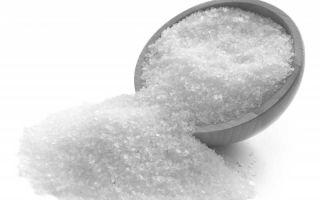Content
Today, the benefits and harms of salt remains a controversial topic, since nutritionists and doctors have not come to a consensus. Some argue that salt is harmful to health, and urge to give it up. Others believe that it is beneficial for the body, since it takes part in many vital processes. What is the use of this mineral, in what cases the use of salt can harm a person and whether it is worth giving up or it is absolutely impossible to do this - these questions remain relevant.
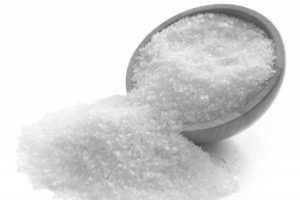
Salt types
Many people know only the most popular types of salt - common attorney and sea salt. However, in fact, the list of varieties of this mineral is much wider:
- Cookery - the most widespread, industrially refined rock salt. In the process of cleaning by boiling, most of the trace elements are removed from it, therefore the final product has minimal benefit;
- Extra - consists of pure sodium chloride, all useful trace elements are removed during the evaporation process. It is considered the most aggressive and harmful species, since it promotes water retention in the body;
- Iodized - enriched with potassium iodate. It is considered beneficial for people with an enlarged thyroid gland;
- Marine - has the greatest health benefits, since it contains many microelements necessary for a person;
- Black Is an unrefined natural mineral salt with a characteristic sulfur odor. With prolonged use, it tends to improve the functioning of the digestive system, and also has a sedative effect on the nervous system;
- Dietary - has a reduced sodium chloride content. This type will be useful for people suffering from chronic kidney and cardiovascular diseases, as well as obesity.
Scientists believe that of all the variety, the unrefined species of this natural mineral are most beneficial. They contain all the trace elements necessary for the normal functioning of body systems.
Salt composition
Edible salt, depending on the deposit, is 94 - 99% composed of sodium chloride (NaCl), as well as impurities such as potassium, magnesium, bromine, iron, calcium, etc.
Why salt is useful for the body
The beneficial properties of this mineral are of great importance for the health of the human body. Sodium is responsible for generating electrical impulses in nerve cells, allowing muscles to function normally. In addition, it regulates water balance in the body. Chlorine takes part in metabolic processes, helping in the synthesis of hydrochloric acid in the stomach and the breakdown of fats.
The benefits of salt for the human body are based on its main properties:
- be responsible for cell renewal;
- take part in digestion;
- promote better absorption of carbohydrates;
- thin blood and lymph;
- promote the formation of red blood cells;
- remove carbon dioxide;
- have antibacterial and antioxidant effects.
The mineral is irreplaceable, and its deficiency is harmful to health, since without it normal functioning of all vital systems of the body is impossible. With prolonged rejection of salt, a person begins to feel nausea, dizziness, weakness and drowsiness.
The benefits and harms of edible sea salt depend on the correctness of its use, and despite all the advantages, it is categorically not recommended to abuse it.
Salt and weight loss
People who are overweight should be very careful when salt food. This is because the supplement tends to retain water in the body, so excessive consumption does not contribute to weight loss. In addition, it enhances salivation and the production of gastric juice, as a result of which appetite increases.
Daily intake of salt
An adult needs approximately 15 g of sodium chloride per day. At the same time, a person gets 10 g from food such as meat, fish, cottage cheese, bread and vegetables. It turns out that pure salt consumption is limited to 5 grams per day, which is about half a teaspoon. Eating large quantities is considered harmful, since its property of retaining water makes the cardiovascular and urinary systems work in an enhanced mode.
What foods contain sodium
The sodium in salt is the main source of your daily requirement. But, besides this, a person gets this mineral from such products:
- meat;
- Fish and seafood;
- bakery products;
- cheese;
- seaweed;
- green pea;
- canned vegetables.
Sauces such as ketchup, mustard, and ready-made salad dressings are high in sodium. For example, a tablespoon of soy sauce contains half the daily value of this trace element.
Table salt treatment
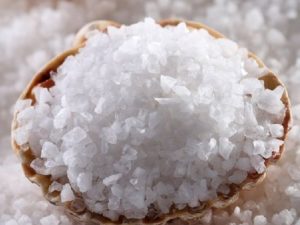
Common table salt has long been used with the benefit of external treatment of various diseases, because it has antibacterial and disinfecting properties. It is used for rinsing, rinsing, dressing, soaking and bathing.
With the help of lotions, they fight such diseases:
- angina, laryngitis, tracheitis;
- mastopathy;
- gout, arthritis, rheumatism;
- migraine.
Rinse the mouth with a solution of sodium chloride for various stomatitis and inflammation of the gums. The benefits of rinsing your mouth with salt are to disinfect the affected areas and reduce tissue inflammation. Antibacterial properties inhibit the growth of pathogenic bacteria, which promotes a speedy recovery.
Salt baths successfully fight most fungal infections of the feet, and in case of bruises and dislocations, dressings are made with wet salted gruel.
The use of sea salt for medicinal purposes
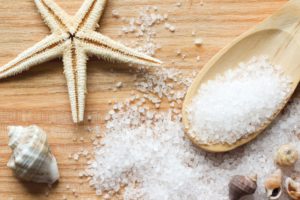
The use of such salt lies in its rich mineral composition, and its medicinal properties are an order of magnitude higher than that of the table. Trace elements such as calcium, bromine, zinc, iron, iodine and others make it an indispensable drug in traditional medicine.
Sea salt has medicinal properties:
- antiseptic;
- anti-inflammatory;
- pain relievers.
Its benefits are also manifested in improving tissue regeneration. A bath with its addition improves skin tone and elasticity.
How salt is used in cosmetology
The cosmetic properties of salt are used with benefit in the composition of cosmetics for the care of the skin of the face and body:
- for whitening;
- healing wounds;
- resistance to allergies.
Cosmetics based on this mineral normalize the functioning of the sebaceous glands and saturate the skin with useful microelements. Therefore, it is widely used in cosmetology in many spas.
It is even useful to just wash your face with salt water - it has a tonic effect, and the skin will be velvety and silky.
For face
The benefits of salt for the skin of the face lie in its anti-inflammatory properties, relieving irritation in the inflamed areas. Young people with problem skin with acne are advised to wash with a sodium chloride solution once a day.
It will also be useful to wash your face with salt at the first signs of aging of the skin: this is a great way to slow down the aging of cells.
To prepare a pure solution for 200 ml of purified water, take 1 hour. L. mineral. The resulting solution is rubbed onto the face once a day before applying the nourishing cream.
For hair and scalp

When used regularly, the benefits of salt on the scalp are manifested in stimulating hair growth, reducing hair loss and healthy condition. In addition, it regulates the work of the sebaceous glands, which has a beneficial effect on the condition of the epidermis and is the prevention of dandruff.
The benefits of sea salt for hair are higher, but if it is not at hand, table salt is also suitable. On its basis, you can prepare a mask for cleaning the scalp, as well as nourishing and strengthening hair. For this, 1 tbsp. l. the mineral is mixed with one banana, mashed into gruel, and applied to the skin and hair. Then they wrap the head with a towel, leave it for 30 minutes, then wash it off. Such a mask cannot be done in cases where there is any mechanical damage to the dermis, otherwise it can cause even more harm.
For body
Body scrubs are made on the basis of sodium chloride; it can also be added to the water when taking a bath. It has a calming effect on the nervous system and strengthening immunity.
The benefits of body salt include:
- in cleaning the skin of dead cells;
- removal of toxins and harmful substances through the pores;
- getting rid of excess moisture.
As for the salt peeling, its benefits will be higher when carrying out the procedure with the sea variety. The usual cooking one will simply cleanse the dermis, while the sea one will nourish it with useful macro- and microelements.
To make a body scrub, take 1 cup of salt and mix 0.5 cups of massage oil. Gently rub into the whole body, leave for 5 - 10 minutes, then rinse.
For legs
Salt water baths are widely used for feet. This procedure relieves swelling and relieves fatigue. The benefits of sea salt for the feet are to treat rough skin and brittle nails. Regular baths will make the surface of the feet soft and the nails healthy.
To prepare a bath for 1 liter of water, take 2 tbsp. l. mineral. The water must be hot, at least 50 ° C. Legs soar for 15 - 20 minutes, adding a hot solution if necessary.
Brushing your teeth with salt
With the help of this procedure, you can effectively whiten tooth enamel without resorting to expensive drugs. The benefits of brushing your teeth with salt is manifested in a beneficial effect on the properties of enamel, improving its structure.
The salt penetrates deeply into the structure of the surface layers of the enamel, removing dirt and brightening it. Antibacterial and disinfecting properties prevent gum inflammation and cavities, and also help to eliminate bad breath.
In order to brush your teeth with this method, you should wet the toothbrush, and then dip it into a container with salted crystals. The adhered particles are quite enough for the procedure.
Why is salt harmful
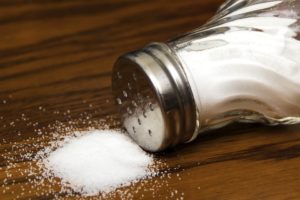
Despite the clear benefits for human health, it is no coincidence that salt is called the "white death": its excessive use is very harmful to health. The body is able to excrete together with urine and then about 25 g of sodium chloride, the rest of the excess will accumulate. Over time, such accumulation will manifest itself as health problems, edema, since the water balance and the balance between potassium and sodium are disturbed.
The property of the mineral to retain water leads to an increase in the circulating blood volume and, as a result, an increase in blood pressure.
The harm from salt abuse is:
- in an increased risk of heart attack;
- the development of coronary heart disease;
- increased risk of kidney stone disease;
- an increased risk of stomach cancer.
Statistics show that 68% of people diagnosed with stomach cancer preferred salty foods.
However, a lack of salt can also be harmful. It has been proven that if you reduce the intake by a third, insulin resistance increases, and this leads to a deterioration in glucose absorption. As a result, type 2 diabetes mellitus or obesity develops.
Is salt good for children
For a child, salt provides the same benefits as for an adult: moderately salted food will not harm a growing body. It is important to remember that sodium chloride found naturally in vegetables, meat and fish will be more beneficial for the health of the child. Therefore, the menu should be composed of foods rich in sodium and potassium, while slightly undersalting the finished dish.
Lack of salt in the baby's diet is harmful to his health and can lead to loss of appetite, muscle weakness and spasms, and decreased immunity. It is better to add sea salt to food - the benefits of its use for a growing body that needs the necessary trace elements will be irreplaceable.
Harm of salt for pregnant women and lactating

Many women who are carrying a child really want something salty, because they absorb a large amount of conservation. However, from the point of view of health benefits and harms, pregnant women are contraindicated to eat salt in the following cases:
- renal failure;
- hypertension;
- chronic kidney disease.
For a healthy woman, the use of sodium chloride will not harm, and even, on the contrary, its daily rate should be slightly higher. With severe edema, doctors advise limiting salt intake for several days, however, as soon as the condition stabilizes, it is imperative to introduce it into the diet in sufficient quantities.
Breastfeeding mothers should lower their daily intake a little - this will improve lactation. However, it is impossible to completely abandon salt, because with the mother's milk, the child replenishes her reserves. And its deficiency for a woman's body will negatively affect health.
How to choose salt
It is important to remember: in addition to giving dishes a brighter and richer taste, salt should be beneficial to the body, so the sea variety should be preferred.
When choosing common salt, you should pay attention to the method of its production and the degree of purification. The most useful is unrefined, coarsely ground, which is best used for cosmetic procedures. Grade I and II salt are suitable for culinary purposes. The highest grade is convenient to use at the table: its crystals are small, pure, but practically have no useful properties.
Conclusion
Summing up, we can say that the benefits and harms of salt for humans depend on the amount of its use, as well as the quality of the product itself. If you do not exceed the daily norm and use sea salt (black, iodized), this mineral will not harm your health. However, it is worth remembering that abuse is fraught with consequences in the form of dangerous diseases, up to and including death.

